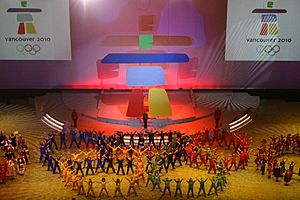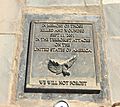Inuksuk facts for kids
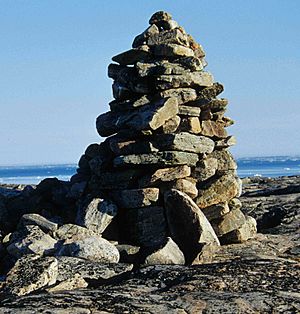
An inuksuk (pronounced in-ook-shook) is a special type of stone landmark built by Indigenous peoples in the Arctic. These include the Inuit, Iñupiat, Kalaallit, and Yupik peoples. You can find these stone structures in places like northern Canada, Greenland, and Alaska (United States). This cold, northern region, above the Arctic Circle, is mostly tundra with very few natural landmarks.
Historically, inuksuit were used for many important things. They helped people navigate, acting as points of reference or markers for travel routes. They also marked good fishing spots, camps, and hunting grounds. Some were used as places for spiritual respect or as fences to help hunt caribou. The Iñupiat in Alaska even used inuksuit to guide caribou into areas where they could be hunted. These stone structures, which come in many shapes and sizes, have been a part of Inuit culture for a very long time.
Most inuksuit are built by carefully stacking stones one on top of another. The simplest kind is just a single stone standing upright. Some inuksuit are so big that building them was likely a group effort. At Inuksuk Point on Baffin Island, there are over 100 inuksuit! This special place was recognized as a National Historic Site of Canada in 1969.
What is an Inuksuk?
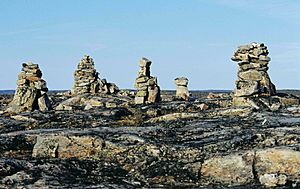
The word inuksuk means "something that acts like a human." It comes from the Inuit word inuk (meaning "person") and -suk (meaning "substitute"). So, an inuksuk is like a stand-in for a person, guiding you or marking a spot.
While many people spell it "inukshuk" in English, the governments of Nunavut and Canada prefer the Inuit spelling, "inuksuk."
A different type of stone structure, called an inunnguaq (pronounced in-oon-ngoo-ak), looks like a human figure. This type has become well-known outside of Inuit communities, especially in Greenland. However, it's important to remember that an inunnguaq is a specific kind of inuksuk, not the most common one.
Inuksuit Today
Inuksuit are still a very important symbol for Inuit culture. An inuksuk is the main image on the flag and coat of arms of the Canadian territory of Nunavut. It's also on the flag of Nunatsiavut. Even a high school in Iqaluit is named Inuksuk High School.
Inuksuit, especially the human-shaped inunnguaq type, have also become a wider Canadian symbol. In 1999, "Inukshuk" was the name of an international art and music project that connected artists across the Arctic and Europe.
On July 13, 2005, Canadian soldiers built an inuksuk on Hans Island. This was part of a long-standing friendly disagreement with Denmark over the small Arctic island. Large inuksuit have also been built across Canada, often welcoming visitors to tourist areas. For example, a 9-meter (30-foot) inuksuk stands in Toronto by Lake Ontario. It was built to remember the World Youth Day 2002 festival held there.
An inunnguaq was chosen as the logo for the 2010 Winter Olympics in Vancouver. This design was created by artist Elena Rivera MacGregor. Its use caused some discussion among Inuit and First Nations people in British Columbia. However, many believe it honors a large inuksuk built in 1986 at English Bay. Both the English Bay structure and the Olympic logo represent friendship and welcoming the world.
The Vancouver 2010 logo helped make inuksuit more recognized around the world. Canada has even donated authentic inuksuit to other countries. You can find them in Brisbane, Australia; Monterrey, Mexico; Oslo, Norway; Washington, D.C., United States; and Guatemala City, Guatemala.
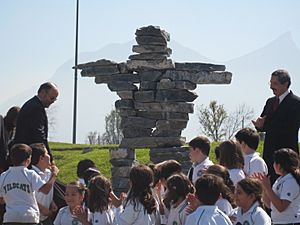
In October 2007, an inuksuk was built in Monterrey, Mexico, by Inuvialuit artist Bill Nasogaluak. This sculpture was a gift from Canada to the people of Nuevo León. It stands along the Santa Lucía Riverwalk. The artist chose local rocks for the structure but brought two special rocks from Canada: one from the Arctic and one from his hometown of Toronto. These two rocks form the inuksuk's "heart."
The inuksuk was also used as a symbol for the Summit of the Americas. It represented "guidance and unity towards common goals."
Sometimes, park officials in Canada take down inuksuit built by hikers. They worry these unofficial markers might confuse visitors and lead them away from official hiking trails. Building inuksuit in parks has become so common that Killarney Provincial Park in Ontario asked visitors to "stop the invasion" of inuksuit in 2007.
Many inuksuit have been built along the Trans-Canada Highway, especially in Northern Ontario. In 2010, a journalist counted 93 inuksuit along Ontario Highway 69 between Sudbury and Parry Sound. One person who built two of them said he felt a strong urge to do it while driving home from a family funeral.
In 2015, a group of women near Hamilton, Ontario, built 1,181 small inuksuit. They did this to remember Missing and Murdered Indigenous Women and to ask the government for action. This act of activism was part of a larger movement across Canada. That same year, the newly elected government promised to start a national investigation into the issue.
According to Guinness World Records, the tallest inuksuk is in Schomberg, Ontario, Canada. It was built in 2007 and stands 11.377 meters (about 37 feet) tall.
In 2018, Canada's Minister of Justice, Jody Wilson-Raybould, gave an inuksuk as a gift to the International Criminal Court (ICC) in The Hague. This gift marked Canada's support for the ICC and its commitment to working with First Nations in Canada.
In Popular Culture
The Canadian rock band Rush featured an inuksuk on the cover of their 1996 album Test for Echo.
Images for kids
-
Inukshuk marking Canada's building site at Auroville, Tamil Nadu, India
-
Inuksuk gardens at Peggy's Cove, Nova Scotia, Canada
-
Inuksuit in Auyuittuq National Park, Baffin Island, Nunavut, Canada
-
Inuksuk on shore of Sẁiẁs Provincial Park, Osoyoos Lake, British Columbia
-
Inuksuk sculpture by David Ruben Piqtoukun in the lobby, Canadian Embassy, Washington, D.C.
-
Very small Inuksuk in Drumheller, Alberta
See also
 In Spanish: Inukshuk para niños
In Spanish: Inukshuk para niños
- Badlands Guardian
- Cairn
- Dolmen
- Herma
- Monolith
- Missing and murdered Indigenous women
- Petroform
- Rock art
- Serge (religious)
- Totem pole



